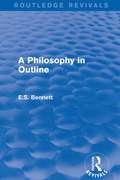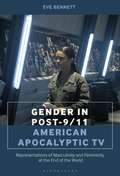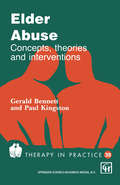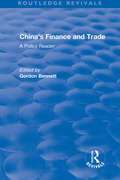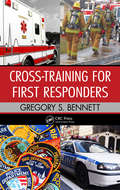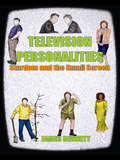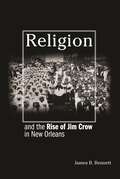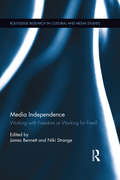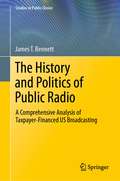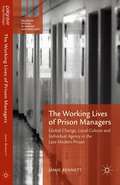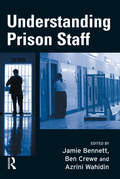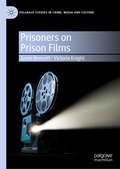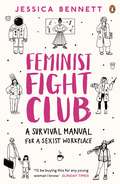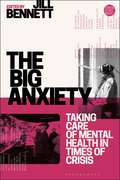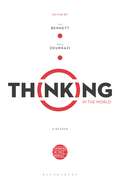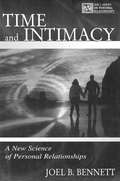- Table View
- List View
A Philosophy in Outline (Routledge Revivals)
by E.S. BennettFirst published in 1931, this book provides a brief overview of the essentials of philosophy. It aims to combat the notion of the inaccessibility of philosophy by providing an introduction to its history and what the author believes to a ‘minimum dose…of incontrovertible philosophical truth’. The book merely assumes an ordinary level of adult education and offers an outline of the key areas of philosophy — consciousness, reality, experience, Life, God, love, aesthetics, conduct, logic — and as such will be of interest as a very useful starting point for anyone wishing to undertake further studies.
A Philosophy in Outline (Routledge Revivals)
by E.S. BennettFirst published in 1931, this book provides a brief overview of the essentials of philosophy. It aims to combat the notion of the inaccessibility of philosophy by providing an introduction to its history and what the author believes to a ‘minimum dose…of incontrovertible philosophical truth’. The book merely assumes an ordinary level of adult education and offers an outline of the key areas of philosophy — consciousness, reality, experience, Life, God, love, aesthetics, conduct, logic — and as such will be of interest as a very useful starting point for anyone wishing to undertake further studies.
Gender in Post-9/11 American Apocalyptic TV: Representations of Masculinity and Femininity at the End of the World
by Eve BennettIn the years following 9/11, American TV developed a preoccupation with apocalypse. Science fiction and fantasy shows ranging from Firefly to Heroes, from the rebooted Battlestar Galactica to Lost, envisaged scenarios in which world-changing disasters were either threatened or actually took place. During the same period numerous commentators observed that the American media's representation of gender had undergone a marked regression, possibly, it was suggested, as a consequence of the 9/11 attacks and the feelings of weakness and insecurity they engendered in the nation's men.Eve Bennett investigates whether the same impulse to return to traditional images of masculinity and femininity can be found in the contemporary cycle of apocalyptic series, programmes which, like 9/11 itself, present plenty of opportunity for narratives of damsels-in-distress and heroic male rescuers. However, as this book shows, whether such narratives play out in the expected manner is another matter.
Gender in Post-9/11 American Apocalyptic TV (PDF): Representations of Masculinity and Femininity at the End of the World
by Eve BennettIn the years following 9/11, American TV developed a preoccupation with apocalypse. Science fiction and fantasy shows ranging from Firefly to Heroes, from the rebooted Battlestar Galactica to Lost, envisaged scenarios in which world-changing disasters were either threatened or actually took place. During the same period numerous commentators observed that the American media's representation of gender had undergone a marked regression, possibly, it was suggested, as a consequence of the 9/11 attacks and the feelings of weakness and insecurity they engendered in the nation's men.Eve Bennett investigates whether the same impulse to return to traditional images of masculinity and femininity can be found in the contemporary cycle of apocalyptic series, programmes which, like 9/11 itself, present plenty of opportunity for narratives of damsels-in-distress and heroic male rescuers. However, as this book shows, whether such narratives play out in the expected manner is another matter.
Elder Abuse: Concepts, theories and interventions (Therapy in Practice Series)
by Gerry Bennett Paul W. KingstonReival: A Policy Reader (Routledge Revivals)
by Gordon A. BennettThis title was first published in 1978. For students of politics the documents in this collection offer an opportunity to analyze a broad policy area - finance and commerce - in search of specific mechanisms by which dictatorship and popular will are both given expression in political life.
Reival: A Policy Reader (Routledge Revivals)
by Gordon A. BennettThis title was first published in 1978. For students of politics the documents in this collection offer an opportunity to analyze a broad policy area - finance and commerce - in search of specific mechanisms by which dictatorship and popular will are both given expression in political life.
Cross-Training for First Responders
by Gregory BennettThe tragedy that occurred in the United States on September 11, 2001 brought enhanced emergency preparedness among first responders to the forefront of public awareness. Since those events � and despite significant progress made in many of the areas previously deemed deficient � some response areas are still woefully inadequate. Cross-Training for
Television Personalities: Stardom and the Small Screen
by James BennettTelevision Personalities offers an exciting, engaging approach to studying and understanding the most prominent and popular performers in television and celebrity culture. It is an original, indispensable guide for undergraduate and postgraduate students of media, television and celebrity studies, as well as those interested in digital culture more widely.
Television Personalities: Stardom and the Small Screen
by James BennettTelevision Personalities offers an exciting, engaging approach to studying and understanding the most prominent and popular performers in television and celebrity culture. It is an original, indispensable guide for undergraduate and postgraduate students of media, television and celebrity studies, as well as those interested in digital culture more widely.
Religion and the Rise of Jim Crow in New Orleans
by James B. BennettReligion and the Rise of Jim Crow in New Orleans examines a difficult chapter in American religious history: the story of race prejudice in American Christianity. Focusing on the largest city in the late-nineteenth-century South, it explores the relationship between churches--black and white, Protestant and Catholic--and the emergence of the Jim Crow laws, statutes that created a racial caste system in the American South. The book fills a gap in the scholarship on religion and race in the crucial decades between the end of Reconstruction and the eve of the Civil Rights movement. Drawing on a range of local and personal accounts from the post-Reconstruction period, newspapers, and church records, Bennett's analysis challenges the assumption that churches fell into fixed patterns of segregation without a fight. In sacred no less than secular spheres, establishing Jim Crow constituted a long, slow, and complicated journey that extended well into the twentieth century. Churches remained a source of hope and a means of resistance against segregation, rather than a retreat from racial oppression. Especially in the decade after Reconstruction, churches offered the possibility of creating a common identity that privileged religious over racial status, a pattern that black church members hoped would transfer to a national American identity transcending racial differences. Religion thus becomes a lens to reconsider patterns for racial interaction throughout Southern society. By tracing the contours of that hopeful yet ultimately tragic journey, this book reveals the complex and mutually influential relationship between church and society in the American South, placing churches at the center of the nation's racial struggles.
Religion and the Rise of Jim Crow in New Orleans
by James B. BennettReligion and the Rise of Jim Crow in New Orleans examines a difficult chapter in American religious history: the story of race prejudice in American Christianity. Focusing on the largest city in the late-nineteenth-century South, it explores the relationship between churches--black and white, Protestant and Catholic--and the emergence of the Jim Crow laws, statutes that created a racial caste system in the American South. The book fills a gap in the scholarship on religion and race in the crucial decades between the end of Reconstruction and the eve of the Civil Rights movement. Drawing on a range of local and personal accounts from the post-Reconstruction period, newspapers, and church records, Bennett's analysis challenges the assumption that churches fell into fixed patterns of segregation without a fight. In sacred no less than secular spheres, establishing Jim Crow constituted a long, slow, and complicated journey that extended well into the twentieth century. Churches remained a source of hope and a means of resistance against segregation, rather than a retreat from racial oppression. Especially in the decade after Reconstruction, churches offered the possibility of creating a common identity that privileged religious over racial status, a pattern that black church members hoped would transfer to a national American identity transcending racial differences. Religion thus becomes a lens to reconsider patterns for racial interaction throughout Southern society. By tracing the contours of that hopeful yet ultimately tragic journey, this book reveals the complex and mutually influential relationship between church and society in the American South, placing churches at the center of the nation's racial struggles.
Media Independence: Working with Freedom or Working for Free? (Routledge Research in Cultural and Media Studies)
by James Bennett Niki StrangeMedia independence is central to the organization, make-up, working practices and output of media systems across the globe. Often stemming from western notions of individual and political freedoms, independence has informed the development of media across a range of platforms: from the freedom of the press as the "fourth estate" and the rise of Hollywood’s Independent studios and Independent television in Britain, through to the importance of "Indy" labels in music and gaming and the increasing importance of independence of voice in citizen journalism. Media independence for many, therefore, has come to mean working with freedom: from state control or interference, from monopoly, from market forces, as well as freedom to report, comment, create and document without fear of persecution. However, far from a stable concept that informs all media systems, the notion of media independence has long been contested, forming a crucial tension point in the regulation, shape, size and role of the media around the globe. Contributors including David Hesmondhalgh, Gholam Khiabany, José van Dijck, Hector Postigo, Anthony Fung, Stuart Allan and Geoff King demonstrate how the notion of independence has remained paramount, but contested, in ideals of what the media is for, how it should be regulated, what it should produce and what working within it should be like. They address questions of economics, labor relations, production cultures, ideologies and social functions.
Media Independence: Working with Freedom or Working for Free? (Routledge Research in Cultural and Media Studies)
by James Bennett Niki StrangeMedia independence is central to the organization, make-up, working practices and output of media systems across the globe. Often stemming from western notions of individual and political freedoms, independence has informed the development of media across a range of platforms: from the freedom of the press as the "fourth estate" and the rise of Hollywood’s Independent studios and Independent television in Britain, through to the importance of "Indy" labels in music and gaming and the increasing importance of independence of voice in citizen journalism. Media independence for many, therefore, has come to mean working with freedom: from state control or interference, from monopoly, from market forces, as well as freedom to report, comment, create and document without fear of persecution. However, far from a stable concept that informs all media systems, the notion of media independence has long been contested, forming a crucial tension point in the regulation, shape, size and role of the media around the globe. Contributors including David Hesmondhalgh, Gholam Khiabany, José van Dijck, Hector Postigo, Anthony Fung, Stuart Allan and Geoff King demonstrate how the notion of independence has remained paramount, but contested, in ideals of what the media is for, how it should be regulated, what it should produce and what working within it should be like. They address questions of economics, labor relations, production cultures, ideologies and social functions.
The History and Politics of Public Radio: A Comprehensive Analysis of Taxpayer-Financed US Broadcasting (Studies in Public Choice #41)
by James T. BennettThis book presents an absorbing study of how educational radio, which originated to broadcast weather forecasts to farmers, has become what the Pew Center calls the most trusted source of news for American liberals and a regular in the rogue's gallery of election-year conservative targets.The Nielsen Company reported in late 2019 that 272 million Americans listen to "traditional radio" each week, a number exceeding those who watch television, use a smartphone, or access the Internet. Yet almost from the start, radio has also been flayed as a noise box of inanity, a transmitter of low-brow entertainment, an instrument of cultural degradation promoting vapid popular music, and a medium whose ultimate purpose is to convince listeners to purchase the goods and services incessantly hawked by the advertisers who underwrite the programs and allegedly dictate content. At the same time, an alternative conception of radio existed as a vehicle for education and for cultural and intellectual (and even political) enlightenment. Most proponents of this perspective disdained advertising revenue and sought subsidies from foundations, wealthy patrons, or varying levels of government.The long, winding road of educational radio led eventually to the creation of National Public Radio (NPR), a fixture on the left of the dial that can be seen as either the consummation or corruption of the educational radio movement. Prized by many liberals, especially affluent whites, and disparaged by many conservatives, NPR has become a potent symbol of the political polarization and cultural chasm that now characterizes the American conversation.
The Working Lives of Prison Managers: Global Change, Local Culture and Individual Agency in the Late Modern Prison (Palgrave Studies in Prisons and Penology)
by Jamie BennettThis book offers the first ethnographic account of prison managers in England. It explores how globalised changes, in particular managerialism, have intersected with local occupational cultures, positioning managers as micro-agents in the relationship between the global and local that characterises late modernity. The Working Lives of Prison Managers addresses key aspects of prison management, including how individuals become prison managers, their engagement with elements of traditional occupational culture, and the impact of the 'age of austerity'. It offers a particular focus on performance monitoring mechanisms such as indicators, audits and inspections, and how these intersect with local culture and individual identity. The book also examines important aspects of individual agency, including values, discretion, resistance and the use of power. It also reveals the 'hidden injuries' of contemporary prison managerialism, especially the distinctive effects experienced by women and members of minority ethnic groups.
Understanding Prison Staff
by Jamie Bennett Ben Crewe Azrini WahidinThe past decade has seen dramatic growth in every area of the prison enterprise. Yet our knowledge of the inner life of the prison remains limited. This book aims to redress this research gap by providing insight into various aspects of the daily life of prison staff. It provides a serious exploration of their work and, in doing so, will seek to draw attention to the variety, value and complexity of work within prisons. This book will provide practitioners, students and the general reader with a comprehensive and accessible guide to the contemporary issues and concerns facing prison staff.
Understanding Prison Staff (PDF)
by Jamie Bennett Ben Crewe Azrini WahidinThe past decade has seen dramatic growth in every area of the prison enterprise. Yet our knowledge of the inner life of the prison remains limited. This book aims to redress this research gap by providing insight into various aspects of the daily life of prison staff. It provides a serious exploration of their work and, in doing so, will seek to draw attention to the variety, value and complexity of work within prisons. This book will provide practitioners, students and the general reader with a comprehensive and accessible guide to the contemporary issues and concerns facing prison staff.
Prisoners on Prison Films (Palgrave Studies in Crime, Media and Culture)
by Jamie Bennett Victoria KnightThis book explores how an audience of men serving sentences in an English prison responded to viewing five contemporary British prison films. It examines how media representations of prison vary in style and content, how film can influence public attitudes, and how this affects people in prison. The book explains the ways in which film acts as a power resource, presenting an ideological vision of criminal justice. The audience used these films to map the social terrain of prison, including issues of power and resistance; race and racism; corruption and the illicit economy; and staff-prisoner relationships, themes which are explored in the films screened. The authors argue that media consumption is one of the ways in which people in prison construct and maintain an ideal of the prisoner culture and what it is to be a ‘prisoner’. The book also reveals the ways in which audience members’ media choices and readings are part of the ongoing process of constructing their self-identity. This book illuminates the complex ways in which media consumption is an integral part of social power, cultural formation and identity construction. Recognising and engaging with audiencehood offers one potential route for supporting more progressive penal practice. This book speaks to those interested in prisons, crime, media and culture, and film studies.
Feminist Fight Club: A Survival Manual For a Sexist Workplace
by Jessica Bennett'Engaging, hilarious and practical - I will proudly proclaim myself a card-carrying member of the FFC' - Sheryl Sandberg, COO of Facebook and bestselling author of Lean InThis is a call to arms.Are you aged zero to infinity? Finished with the sexist status quo? Ready to kick ass and take names?Welcome to the Feminist Fight Club. You have lifetime membership.Feminist Fight Club provides an arsenal of weapons for surviving in an unequal world. You will learn how to fight micro-aggressions, correct unconscious bias, deal with male colleagues who can't stop 'manterrupting' or 'bro-propriating' your ideas - and how to lean in without falling the f*ck over.Every woman needs this book - and they needed it yesterday.This is not a drill.
The Big Anxiety: Taking Care of Mental Health in Times of Crisis (pdf) (Thinking in the World)
by Jill BennettThis book takes a creative approach in examining one of the biggest crises of our time: that of mental suffering, distress and anxiety. By bringing together essays and dialogues from thinkers and artists across a range of disciplines, it re-imagines approaches to crisis, support, and care. Amid growing recognition that mental health is not only the province of psychiatry and the health sector, but a concern for the whole community, the book opens up critical new ways of thinking about our internal lives and the forces that affect them. The book significantly advances the way we think about cultural responses to mental health and the understanding of the struggles of inner life. Featuring both theoretical and practical examples of the value of using imagination in response to trauma, anxiety, and depression, The Big Anxiety shows how creativity is not a luxury, but a means of survival.
The Big Anxiety: Taking Care of Mental Health in Times of Crisis (Thinking in the World)
by Jill BennettThis book takes a creative approach in examining one of the biggest crises of our time: that of mental suffering, distress and anxiety. By bringing together essays and dialogues from thinkers and artists across a range of disciplines, it re-imagines approaches to crisis, support, and care. Amid growing recognition that mental health is not only the province of psychiatry and the health sector, but a concern for the whole community, the book opens up critical new ways of thinking about our internal lives and the forces that affect them. The book significantly advances the way we think about cultural responses to mental health and the understanding of the struggles of inner life. Featuring both theoretical and practical examples of the value of using imagination in response to trauma, anxiety, and depression, The Big Anxiety shows how creativity is not a luxury, but a means of survival.
Thinking in the World: A Reader (Thinking in the World)
by Jill Bennett Mary ZournaziEngaging with contemporary issues responsibly and creatively can become a very abstract activity. We can sometimes find ourselves talking in terms of theories and philosophies which bear very little resemblance to how life is actually lived and experienced. In Thinking in the World, Jill Bennett and Mary Zournazi curate writings and conversations with some of the most influential thinkers in the world and ask them not just why we should engage with the world ,but also how we might do this. Rather than simply thinking about the world, the authors examine the ways in which we think in and with the world. Whether it's how to be environmentally responsible, how to think in film, or how to dance with a non-human, the need to engage meaningfully in a lived way is at the forefront of this collection.Thinking in the World showcases some of the most compelling arguments for a philosophy in action. Including wholly original, never-before-released material from Michel Serres, Alphonso Lingis, and Mieke Bal, the different chapters in this book constitute dialogues and approachable essays, as well as impassioned arguments for a particular way of approaching thinking in the world.
Time and Intimacy: A New Science of Personal Relationships (LEA's Series on Personal Relationships)
by Joel B. BennettThere is a mysterious connection between our experiences of intimacy--of love, the longing to feel connected, and sexual embrace--and the human sense of time--eternity, impermanence, and rhythm. In this critical analysis of the time-intimacy equation, Bennett shows how the scientific study of personal relationships can address this mystery. As a study of transpersonal science, this book points to the possible evolution of intimacy and of our consciousness of time, and how the two evolutionary paths weave together. Dr. Bennett draws from a wide array of resources to advance and marry two compelling themes: first, the social and clinical science of personal relationships should integrate the spiritual or transpersonal dimension of intimacy, and second, science can contribute to lay understandings by describing the richly temporal aspects of relationships. In blending popular literature, transpersonal psychology, and scientific research and theory, this work also attempts to address the lack of dialogue between academics who study personal intimacy and those writers in the popular press who give advice and guidelines for building intimacy. Time and Intimacy is written for a broad audience, intended for those with a general interest in relationships, as well as for students, counselors, and psychologists. It can be used as a text in courses on personal relationships, as well as to supplement courses in humanistic psychology, transpersonal psychology, interpersonal communication, relationships, marital and family counseling, human relations, and related areas. Because it advances an interdisciplinary understanding of personal relationships, this book is certain to challenge prevailing views about the meaning of intimacy in both the academic and popular literatures.
Time and Intimacy: A New Science of Personal Relationships (LEA's Series on Personal Relationships)
by Joel B. BennettThere is a mysterious connection between our experiences of intimacy--of love, the longing to feel connected, and sexual embrace--and the human sense of time--eternity, impermanence, and rhythm. In this critical analysis of the time-intimacy equation, Bennett shows how the scientific study of personal relationships can address this mystery. As a study of transpersonal science, this book points to the possible evolution of intimacy and of our consciousness of time, and how the two evolutionary paths weave together. Dr. Bennett draws from a wide array of resources to advance and marry two compelling themes: first, the social and clinical science of personal relationships should integrate the spiritual or transpersonal dimension of intimacy, and second, science can contribute to lay understandings by describing the richly temporal aspects of relationships. In blending popular literature, transpersonal psychology, and scientific research and theory, this work also attempts to address the lack of dialogue between academics who study personal intimacy and those writers in the popular press who give advice and guidelines for building intimacy. Time and Intimacy is written for a broad audience, intended for those with a general interest in relationships, as well as for students, counselors, and psychologists. It can be used as a text in courses on personal relationships, as well as to supplement courses in humanistic psychology, transpersonal psychology, interpersonal communication, relationships, marital and family counseling, human relations, and related areas. Because it advances an interdisciplinary understanding of personal relationships, this book is certain to challenge prevailing views about the meaning of intimacy in both the academic and popular literatures.
